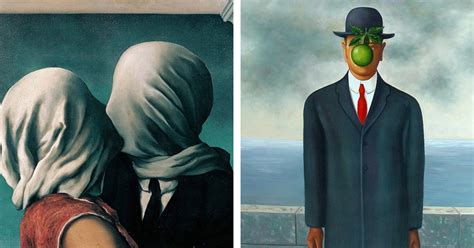In the vast realm of artistic expression, there are a select few individuals whose names evoke intrigue, fascination, and a profound sense of mystery. Such is the case with the legendary figure we delve into today, celebrated as one of the most influential painters of the 20th century in Belgium.
This prodigious talent, known for his masterful manipulation of reality and the interplay of imagination and perception, stands as a paragon of the surrealist movement. His captivating works have left an indelible mark on the artistic landscape, challenging conventional notions and transporting audiences into enigmatic and dreamlike realms.
With a keen eye for detail and a penchant for subversion, this visionary artist shattered barriers and pushed the boundaries of artistic expression. His signature style, characterized by meticulously rendered and thought-provoking imagery, captivates viewers as they embark on a journey through the corridors of the subconscious mind.
Imbued with an air of enigma and ambiguity, this renowned figure's artistry invites viewers to question the nature of reality and the limitations of perception. Immerse yourself in the world of this Belgian surrealist luminary, and discover the depths of his artistic genius, as we unravel the captivating biography of a man who forever altered the artistic landscape of the 20th century.
The Early Life and Influences of René Magritte

In this section, we will delve into the formative years and diverse influences that shaped the artistic journey of the renowned surrealist painter from Belgium. Exploring Magritte's early life will offer insights into the experiences and events that played a pivotal role in shaping his unique artistic style.
1. Family and Childhood
Magritte was born in Lessines, a small town in Belgium, in 1898. Growing up in a middle-class family, he displayed an early passion for art and demonstrated his creativity through drawings and paintings. Despite his father's disapproval of pursuing a career in art, Magritte's mother encouraged his artistic pursuits, nurturing his passion.
2. Influential Figures
During his formative years, Magritte encountered several influential figures who impacted his artistic development. Among them was his first art teacher, Constant Montald, who introduced him to the works of symbolist painters and encouraged him to experiment with different artistic styles. Additionally, encounters with renowned artists such as Giorgio de Chirico and Max Ernst further ignited Magritte's interest in the realm of surrealism.
3. Early Artistic Exploration
Magritte's early artistic exploration was marked by an engagement with various artistic movements of the time, including impressionism and cubism. These encounters with different styles and techniques laid the foundation for his later experimentation with surrealism. As he experimented with different artistic approaches, Magritte gradually developed a distinct visual language that would define his surrealistic works.
4. Philosophical and Literary Influences
In addition to visual art, Magritte drew inspiration from philosophical and literary sources. The works of philosopher Henri Bergson, for instance, influenced his perception of reality and the concept of fragmented existence. Literary figures like Edgar Allan Poe and the writings of the Marquis de Sade also captivated Magritte's imagination, shaping his interest in the contradictory and enigmatic nature of human existence.
5. Belgian Surrealist Movement
Magritte's artistic journey was deeply intertwined with the emergence of the Belgian Surrealist movement. He became an active participant in the group's meetings and exhibitions, collaborating with fellow artists such as Paul Nougé and E. L. T. Mesens. These interactions provided Magritte with a supportive community that fostered his progress as a surrealist artist.
As we explore the early life and influences of René Magritte, it becomes evident that his upbringing, encounters with influential figures, artistic exploration, philosophical and literary inspirations, and participation in the Belgian Surrealist movement all contributed to the development of his unique surrealist style. These factors intertwine to provide a rich backdrop for understanding the artist and his contributions to the art world.
Exploring Magritte's Early Life and Artistic Origins
In this section, we delve into the formative years of the renowned surrealist artist, René Magritte. Through exploring his childhood and artistic beginnings, we gain insight into the factors that shaped his unique artistic style.
Magritte's upbringing played a pivotal role in his artistic development. Growing up in Belgium during the early 20th century, he was exposed to a rich cultural heritage and a vibrant artistic scene. These early influences laid the foundation for his later artistic explorations.
As a young artist, Magritte quickly displayed a distinct style that set him apart. He embraced surrealism as a means of expressing his unconventional ideas and challenging societal norms. With daring and originality, he defied artistic conventions and embarked on a journey of self-expression.
Throughout his career, Magritte's work often featured thought-provoking imagery and unexpected juxtapositions. His unique combination of realism and fantasy captivated audiences and pushed the boundaries of traditional art. Through a masterful blend of symbolism and visual puzzles, he invited viewers to question the nature of reality and the limitations of perception.
By exploring Magritte's early life and artistic origins, we gain a deeper understanding of the influential factors that shaped his extraordinary vision. From his childhood experiences to his rebellious artistic beginnings, his life story provides a fascinating context for interpreting his thought-provoking and enigmatic artworks.
Uncovering the Roots of Magritte's Surrealist Vision
Magritte's artistic journey was not solely shaped by his childhood environment. The artist's unique perspective on art and life was also influenced by personal experiences and encounters throughout his life. As we delve into the details of his early life and artistic origins, we uncover the roots of Magritte's surrealist vision and gain a newfound appreciation for his groundbreaking contributions to the art world.
Join us in exploring the childhood and artistic beginnings of René Magritte, a visionary artist whose imaginative world continues to captivate and inspire audiences today.
Key Influences and Inspirations on Magritte's Surrealist Style

Exploring the artistic journey of René Magritte unveils a profound array of influences and inspirations that played a pivotal role in shaping his distinctive surrealist style. Magritte's artistic evolution, marked by intriguing visual representations and thought-provoking imagery, was greatly influenced by a diverse range of factors that collectively contributed to the creation of his iconic masterpieces.
Literature and Philosophy: Magritte's surrealist vision found fertile ground in the realms of literature and philosophy. Inspired by the works of renowned literary figures such as Edgar Allan Poe and Franz Kafka, Magritte adeptly translated their introspective narratives into visual form. The existential themes and enigmatic atmospheres prevalent in their writings resonated deeply with Magritte, leading to the exploration of profound philosophical ideas within his paintings. |
Surrealist Movement: Being an active participant in the surrealist movement, Magritte drew inspiration from fellow surrealist artists, collectively fueling the innovative spirit of the group. He not only appreciated the works of Salvador Dalí, Max Ernst, and André Breton but also engaged in intellectual discussions and collaborations with them. These interactions with like-minded individuals further nurtured Magritte's surrealist perspective, encouraging him to push the boundaries of traditional artistic conventions. |
Mystery and Illusion: Magritte's fascination with mysteries and illusions played a significant role in his artistic development. Drawing from the world of magic and stage performances, he sought to challenge the viewers' perception and provoke contemplation through visual riddles. The interplay between reality and artistic interpretation became a cornerstone of Magritte's style, offering viewers a chance to question the inherent contradictions within the everyday world. |
Visual Puzzles and Language: An exploration of language and visual puzzles served as a constant source of inspiration for Magritte. His iconic painting "The Treachery of Images," depicting a pipe with the caption "Ceci n'est pas une pipe" ("This is not a pipe"), exemplifies his fascination with the semiotic nature of art. Magritte's keen interest in challenging linguistic and visual norms allowed him to create complex compositions that blurred the lines between representation and reality. |
Analysis of Magritte's Surrealist Masterpieces
In this section, we will delve into the captivating and thought-provoking world of René Magritte's surrealistic masterpieces. Through an in-depth analysis, we aim to uncover the underlying meanings and symbolism present in his renowned artworks.
Magritte's surrealist creations transport viewers to an enigmatic realm where reality and imagination intertwine. Through his exceptional use of symbolism, juxtapositions, and visual illusions, the artist challenges conventional notions of perception and invites contemplation of the subconscious mind.
One of the recurring themes explored in Magritte's masterpieces is the concept of identity and its relationship with objects and surroundings. His iconic bowler-hatted men, faceless figures, and floating objects provoke questions about the essence of human existence and the masks we wear in society.
Furthermore, Magritte's meticulous attention to detail and precise execution enhance the impact of his artwork. From the precise brushstrokes to the careful composition, each element contributes to the overall narrative of the piece, inviting viewers to unravel its hidden messages.
By employing visual paradoxes and juxtapositions, Magritte challenges our perception of reality. He manipulates ordinary objects and landscapes, placing them in unexpected contexts, blurring the boundaries between the real and the unreal. Through this technique, he prompts viewers to question the nature of the world around them and the limitations of their own perception.
In addition to his surrealist imagery, Magritte's masterpieces often incorporate wordplay and linguistic elements. The combination of images and text creates a multi-layered effect, inviting viewers to interpret the artwork from multiple angles and engage with the underlying concepts in a deeper, more introspective manner.
Magritte's surrealistic masterpieces continue to captivate audiences worldwide, challenging them to unravel the mysteries within. Through his innovative techniques and profound exploration of the human psyche, Magritte has cemented his legacy as one of the most influential artists of the 20th century, leaving a lasting impact on the realm of surrealism.
| Key Elements: | Meanings and Symbolism: |
|---|---|
| Visual illusions | Questioning perception and reality |
| Identity and masks | Exploring the essence of human existence |
| Precision and composition | Enhancing narrative and hidden messages |
| Paradoxes and juxtapositions | Blurring boundaries and challenging perception |
| Wordplay and linguistic elements | Creative interpretation and introspection |
Delving into the Symbolism and Thought-provoking Elements

Exploring the profound meaning behind René Magritte's artwork unveils a world of symbolism and captivating elements that stimulate contemplation. Magritte's masterpieces serve as visual puzzles, inviting viewers to delve into a realm where reality and imagination intertwine.
His paintings often feature enigmatic scenarios, where everyday objects assume unexpected roles, challenging our perception of reality. Through meticulous attention to detail, Magritte crafts compositions that provoke curiosity and invite deep introspection.
Symbolism plays a pivotal role in Magritte's work, with recurring motifs such as the bowler hat, the pipe, and the apple. These seemingly ordinary objects are stripped of their conventional meanings and transform into vessels of broader concepts and philosophical inquiries.
The juxtaposition of elements in his paintings creates a surrealistic atmosphere, blurring the boundaries between dream and reality. Objects hover in mid-air, undergo transformations, or merge in unexpected ways, encouraging viewers to question their assumptions and embrace the irrational.
Magritte's use of visual metaphors and wordplay adds another layer of complexity to his art. He often incorporates cryptic texts alongside his images, challenging the observer's preconceived notions and inviting them to engage in a captivating dialogue between image and message.
Exploring the symbolism and thought-provoking elements in Magritte's work presents an opportunity to delve into the profound depths of the human psyche and confront the mysteries of the world we inhabit. It is an invitation to embark on a journey of introspection and contemplation that transcends the boundaries of conventional artistic expression.
FAQ
What is René Magritte best known for?
René Magritte is best known for his surrealist paintings, which often feature ordinary objects in unusual contexts, challenging the viewer's perception of reality.
What influenced René Magritte's artistic style?
René Magritte's artistic style was influenced by the works of Giorgio de Chirico and the concept of surrealism. He was also inspired by the philosophy of René Descartes and the idea of questioning reality.
How did René Magritte's paintings reflect his thoughts on perception?
René Magritte's paintings often played with the viewer's perception by depicting familiar objects in unusual ways or placing them in unexpected contexts. This was a way for him to challenge the notion of reality and encourage viewers to question what they see.



